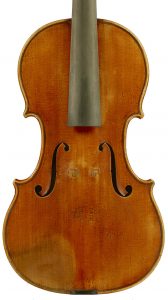Press Release- Researchers discover the technical fingerprint of the violin-makers Stradivari and Storioni
Synchrotron radiation reveals the different varnishing techniques of the two luthier masters
Traditional Cremonese luthierie is behind the construction of musical instruments that became legend. Antonio Stradivari (1644-1737) and Lorenzo Storioni (1744-1816) are two of the many artisans who made the tradition timeless. Thanks to advanced techniques, secrets behind the finishing of some of the best violins ever made were scrutinized. Monica Gulmini (Chemistry department of the University of Turin) and Marco Malagodi (University of Pavia and Arvedi laboratory of non-Invasive diagnostics in Cremona) coordinated the study that revealed the materials employed by Stradivari and Storioni to prepare the wood and to varnishing their violins, thus showing the production’s fingerprint of the two Cremonese masters. The violins “Bracco” (Storioni, 1793), “Toscano” (Stradivari, 1690), and another anonymous violin produced by Storioni in 1790, were analysed in this study.

“After having tested X-rays to analyse these priceless works of art, now we exploited the infrared radiation from the synchrotron”– says Giacomo Fiocco, first author of the study. He is PhD student at the chemistry department of the University of Turin and researcher at the Arvedi laboratory of non-Invasive diagnostics of the University of Pavia. Lisa Vaccari and Chiaramaria Stani supported the experiments conducted at the Elettra synchrotron, the Italian partner facility of the Central European Research Infrastructure Consortium, CERIC-ERIC. Thanks to a CERIC call for proposals, the study’s authors were granted free access to the advanced instrumentations available at the synchrotron in Trieste.
The research highlights the different techniques of the two Cremonese masters. Storioni’s violins are characterised by a 10 micrometer ground coat covered by a varnishing layer of about 60-90 micrometers. On the other hand, in Stradivari’s violins were detected two thin varnishing layers of 10-15 micrometers and no ground coat, which probably penetrated the wood pores. These characteristics represent the fingerprint of the two violin-makers.
Researchers used micrometric samples detached from the violins for their analyses. As Stradivari’s works cover the first five positions among the most valuable musical instruments, we can consider that even those very small samples have an extremely high intrinsic value. Therefore, every single piece of information shall be obtained without damaging them. Samples shall in fact be preserved for further scientific investigations possibly developed in the future. The traditional Cremonese luthiery has been recognised by UNESCO which inscribed it in the Representative List of Intangible Cultural Heritage of Humanity, and scientific investigation supports a deeper knowledge of these amazing artworks.
- ORIGINAL ARTICLE
- PRESS KIT
- CONTACTS: CERIC press office– +39 3349024929
CERIC-ERIC is a multidisciplinary Research Infrastructure open for users in the fields of Materials, Biomaterials and Nanotechnology. With a single entry point to excellent facilities in Europe, it allows structural investigation, analysis and synthesis of materials, using photon, electron, neutron, and ion based techniques.



